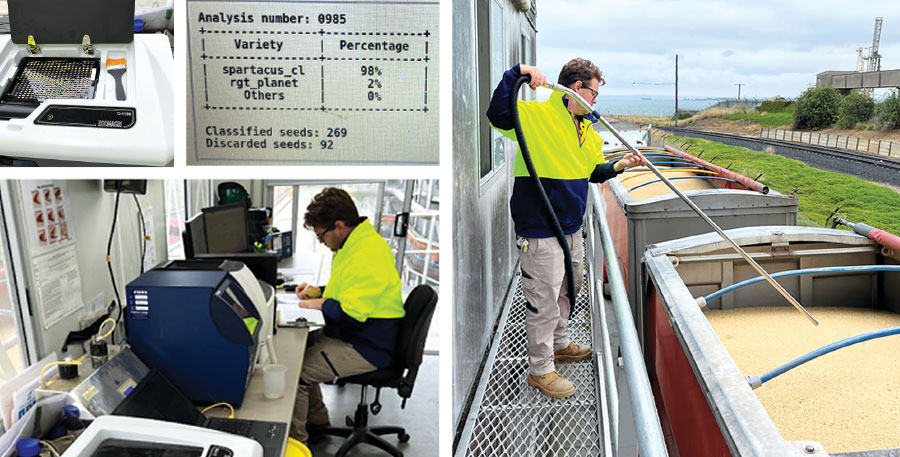Artificial intelligence, computer vision and the Internet of Things are the technical ingredients behind new methods to improve the accuracy and efficiency of grain analysis.
The technology stands to replace time-consuming visual analysis with a fast, objective-measurement process.
A technology and spin-off company, ZoomAgri, is the result of two Argentinian grain traders, Fernando Miguel Martinez de Hoz and Jacob Rommelaar, teaming in 2017 with electrical engineer Matias Micheloud to found ZoomAgri.
Leveraging artificial intelligence, computer vision and the Internet of Things, they are providing accurate, reliable and efficient quality assessment.
ZoomAgri’s Asia-Pacific regional manager, Nicolas Martelli, says the technology provides real-time results and eliminates the need for visual testing. He says this allows everyone in the supply chain to make decisions based on reliable and consistent data.
Being able to better measure quality allows all supply chain stakeholders to be more efficient. Accurately determining the quality and purity of grain before transporting or processing helps reduce overall waste.
"There has been quite a lot of development in hyperspectral imaging in recent years," says Matt Devine, GRDC Manager Value Chain Innovation. "Combined with advances in computing power, these two factors provide an opportunity to explore new solutions to faster and consistent sample testing to deliver time and accuracy savings to Australian growers."
Products
ZoomAgri has two products: ZoomAgriOne, which can determine the variety of barley and wheat, and ZoomAgriSpex, which can determine the quality of coarse grains and oilseeds including corn, soybeans, wheat, and barley. ZoomAgriSpex specifies a number or percentage of broken kernels, skinnings, foreign matter, defects, colour, shape and sieve size. ZoomAgri’s aim, in Australia, is to replicate visual assessments.
A scanner is used to capture an image of a sample, which is processed using ZoomAgri’s proprietary neural networks (a common term for machine learning) that use algorithms to compare the scanned images with preloaded images. The networks are ‘trained’ to classify the sample based on the visual quality traits for that variety and provide results within three minutes.
“By training the artificial intelligence to recognise the quality and variety of grains or oilseeds, ZoomAgri produces consistent results with a minimum of 98 per cent accuracy,” Mr Martelli says.
The database for this contains more than 200 million images of individual grains and oilseeds.
Partnerships
“To develop ZoomAgriOne in Australia, we have partnered with InterGrain, one of the largest plant breeders in the country, to provide us with the high-purity samples required to train our AI algorithms,” Mr Martelli says.
“We have established a strong customer base with some of the biggest maltsters and handlers in the world, including AB InBev, Cargill, Malteries Soufflet, Boortmalt, ADM, Bunge, Cargill Dreyfus, Viterra and Cofco. As well as working with InterGrain in Australia, we work with Malteurop, Coopers, Riordans, the Department of Primary Industries and GrainCorp.”
GrainInnovate investment and support has enabled ZoomAgri to accelerate the development and deployment of its grain variety recognition technology. This investment facilitates further innovation and refinement of the technology, leading to new applications and increased market reach.
Challenges
Developing its solution was not without challenges, Mr Martelli says.
“One of the key challenges we faced was in developing and training our proprietary neural networks to accurately classify a wide range of agricultural commodities across different regions and growing conditions.
This required significant investment in data collection and processing, as well as ongoing refinement and improvement of our algorithms to ensure accuracy and consistency.
“Another challenge was developing a reliable and robust hardware device that could capture high-quality images in different environments and under varying lighting conditions. This required extensive testing and optimisation to ensure that our scanners could consistently produce accurate and reliable data.
“Additionally, we faced challenges in gaining the trust and buy-in of industry stakeholders who were used to traditional testing methods and sceptical of new technologies. To address this, we invested in building strong relationships with industry partners and educating them on the benefits of our solution through targeted marketing and outreach efforts.
“As a global company, we also needed to adapt our technology and approach to the unique cultural, regulatory and market conditions of each country we entered.”
Today, ZoomAgri has customers in 24 countries across six continents.
Case Study: Purity verification in the malt industry
Although the origins of malting are buried in ancient times and probably date back to Egyptian days, the science and specifications of the process continue to be at the forefront of technology.
Malting is the biological process of turning barley into malt and involves three stages: steeping, germination and kilning to dry and stabilise the malt. As each barley variety contains different starches and enzymes that are involved in these stages and behave differently, the malt conditions are customised for each variety.
 Jeremy Thiblet Malteurop, Australia & New Zealand regional operations manager. Photo: Malteurop
Jeremy Thiblet Malteurop, Australia & New Zealand regional operations manager. Photo: Malteurop
For this reason, the varieties are segregated when they are grown, stored, shipped and processed and must be of high quality and purity.
Jeremy Thiblet, Malteurop’s Australia and New Zealand regional operations manager, says Malteurop’s commitment to its malt business starts before any grain enters the process.
“We ensure our suppliers are aware of our quality standards and work with them to ensure they are met,” Mr Thiblet says.
“To do this we have rigorous attention to detail when it comes to incoming grain inspections and testing procedures.”
To make sure the company stays ahead of the curve for managing quality on-site, it has been investing in technology that can verify purity of the barley varieties received.
Where previously we were using the human eye to differentiate between barley varieties, which was fallible and time-consuming, we are now adopting machine vision technology to reduce errors and improve efficiencies by providing real-time information.
For the past two years, every load of malt barley received at Malteurop’s plants has been tested using ZoomAgriOne to ensure it meets at least 90 per cent purity.
“This means that we know exactly how to set our specifications to optimally malt each load that is processed through the malt house,” Mr Thiblet says.
“We have randomly cross-checked samples with genetic analysis and this has confirmed the accuracy of ZoomAgriOne’s analysis.

ZoomAgriOne deployed at Malteurop Geelong barley receival point. Photo: Malteurop
“ZoomAgri also calibrates the machine several times a year and can recalibrate remotely, which is a great advantage.”
Mr Thiblet says that rejecting barley loads that do not meet purity specifications can be costly and inefficient for growers, maltsters and brewers.
“Being able to have full confidence in the purity of a load creates good traceability throughout the supply chain.”
More information: ZoomAgri, Nicolas Martelli, nicolas.martelli@zoomagri.com; Jeremy Thiblet, Jeremy.Thiblet@malteurop.com

























































